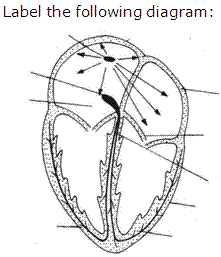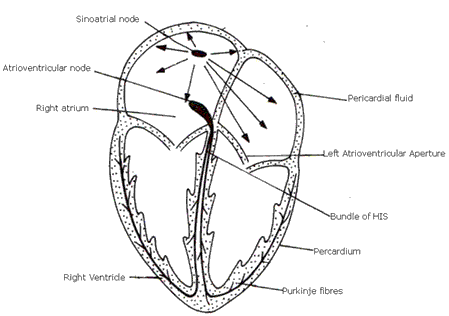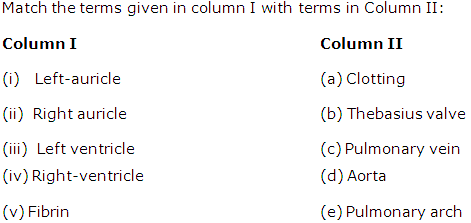Chapter 7 - Circulatory System Exercise 90
Question 1
What is circulatory system? Describe the circulatory system of humans.
Solution 1
Circulatory system: It is a system of organs that takes part in the flow of materials in the body of an organism inside an extracellular fluid.
Circulatory system in humans:
(a) The right atrium receives deoxygenated blood from all the parts of the body through large veins called vena cava.
(b) When the right atrium is full of blood, it contracts and the blood is forced into right ventricle.
(c) When the right ventricle is full of blood, it contracts and the blood is pumped into the pulmonary trunk.
(d) From right ventricle, the pulmonary artery carries the blood to the lungs for oxygenation.
(e) The oxygenated blood returns to the heart via pulmonary veins that empty into the left auricle.
(f) When the left auricle contracts, the blood passes into the left ventricle by the opening of bicuspid valve.
(g) On contraction of the left ventricle, the blood is pumped into the artery called aorta.
(h) The aorta branches into vessels which transports blood to the heart and all the body parts.
Circulatory system in humans:
(a) The right atrium receives deoxygenated blood from all the parts of the body through large veins called vena cava.
(b) When the right atrium is full of blood, it contracts and the blood is forced into right ventricle.
(c) When the right ventricle is full of blood, it contracts and the blood is pumped into the pulmonary trunk.
(d) From right ventricle, the pulmonary artery carries the blood to the lungs for oxygenation.
(e) The oxygenated blood returns to the heart via pulmonary veins that empty into the left auricle.
(f) When the left auricle contracts, the blood passes into the left ventricle by the opening of bicuspid valve.
(g) On contraction of the left ventricle, the blood is pumped into the artery called aorta.
(h) The aorta branches into vessels which transports blood to the heart and all the body parts.
Question 2
Explain the following:
(i) Why is the SA node called the pace-maker of the heart?
(ii) Why is there no mixing of deoxygenated and oxygenated blood in the human heart normally?
(iii) Why is the closed circulatory system more efficient than the open system?
(iv) Why does the left ventricle possess a thicker wall than the right ventricle?
(i) Why is the SA node called the pace-maker of the heart?
(ii) Why is there no mixing of deoxygenated and oxygenated blood in the human heart normally?
(iii) Why is the closed circulatory system more efficient than the open system?
(iv) Why does the left ventricle possess a thicker wall than the right ventricle?
Solution 2
(i) The SA is also called the pacemaker because it establishes the basic frequency at which the heart beats. It starts each heart beat and sets the pace for the whole heart.
(ii) There is no mixing of deoxygenated and oxygenated blood in the human heart because of double circulation of blood where the blood passes twice through the heart and the right half of the heart is concerned with pumping deoxygenated blood while the left is concerned with pumping of oxygenated blood.
(iii) The closed circulatory system is more efficient than the open system because in closed system the blood flows inside arteries or veins all the time which stops the mixing of blood with other bodily fluids and helps the transport of the blood around the body.
(iv) The left ventricle possess a thicker wall than the right ventricle because it pumps the blood at a higher pressure since blood from the left ventricle goes to all areas of the body while the right ventricle only has to pump blood to the lungs which is a much shorter distance, therefore less pressure is required.
(ii) There is no mixing of deoxygenated and oxygenated blood in the human heart because of double circulation of blood where the blood passes twice through the heart and the right half of the heart is concerned with pumping deoxygenated blood while the left is concerned with pumping of oxygenated blood.
(iii) The closed circulatory system is more efficient than the open system because in closed system the blood flows inside arteries or veins all the time which stops the mixing of blood with other bodily fluids and helps the transport of the blood around the body.
(iv) The left ventricle possess a thicker wall than the right ventricle because it pumps the blood at a higher pressure since blood from the left ventricle goes to all areas of the body while the right ventricle only has to pump blood to the lungs which is a much shorter distance, therefore less pressure is required.
Question 3
What are the differences between artery and vein?
Solution 3

Question 4
What are the functions of blood plasma?
Solution 4
The functions of blood plasma : It transports gases and other materials, maintains blood pH, body immunity, body heat regulation and also regulates the osmotic pressure of the blood.
Question 5
What is the double circulation?
Solution 5
Double circulation means during one circulation blood passes twice through the heart. It includes both pulmonary and systemic circulation. It is necessary as it keeps oxygenated and deoxygenated blood separate.
Question 6
What are the materials carried by the blood?
Solution 6
The materials which are carried by the blood are: oxygen, carbon dioxide, water, digested food, organic wastes, hormones and antibodies.
Question 7
What is the main function of erythrocytes?
Solution 7
The main function of erythrocytes is to transport the respiratory gases - CO2 and O2.
Question 8
Name the following:
(i) The soluble protein present in the blood plasma responsible for clotting.
(ii) The process by which leucocytes engulf and destroy bacteria.
(iii) The iron containing pigment in the erythrocytes.
(iv) The phase of the cardiac cycle in which auricle contracts.
(v) The study of blood vascular and lymphatic system.
(vi) The inflammation of pericardium.
(vii) The valve of right auriculo-ventricular aperture.
(viii) In embryological stage right and left auricles are communicated by.
(ix) Abnormal rise in RBC number.
(x) The first heart sound.
(i) The soluble protein present in the blood plasma responsible for clotting.
(ii) The process by which leucocytes engulf and destroy bacteria.
(iii) The iron containing pigment in the erythrocytes.
(iv) The phase of the cardiac cycle in which auricle contracts.
(v) The study of blood vascular and lymphatic system.
(vi) The inflammation of pericardium.
(vii) The valve of right auriculo-ventricular aperture.
(viii) In embryological stage right and left auricles are communicated by.
(ix) Abnormal rise in RBC number.
(x) The first heart sound.
Solution 8
(i) Fibrinogen
(ii) Phagocytosis
(iii) Haemoglobin
(iv) Auricular systole
(v) Angiology
(vi) Pericarditis
(vii) Tricuspid valve
(viii) Foramen ovale
(ix) Polycythemia
(x) Lubb
(ii) Phagocytosis
(iii) Haemoglobin
(iv) Auricular systole
(v) Angiology
(vi) Pericarditis
(vii) Tricuspid valve
(viii) Foramen ovale
(ix) Polycythemia
(x) Lubb
Chapter 7 - Circulatory System Exercise 91
Question 1

Solution 1
(i)Inferior vena cava, superior vena cava and coronary sinus
(ii) Ventricles
(iii) Function of bicuspid valve: It prevents the reverse flow of blood from the left ventricle into the left auricle.
(iv) Function of tricuspid valve: It prevents the reverse flow of blood from the right ventricle into the right auricle.
(ii) Ventricles
(iii) Function of bicuspid valve: It prevents the reverse flow of blood from the left ventricle into the left auricle.
(iv) Function of tricuspid valve: It prevents the reverse flow of blood from the right ventricle into the right auricle.
Question 2

Solution 2

Question 3

Solution 3
(i) (c) Pulmonary vein
(ii) (b) Thebasius valve
(iii) (d) Aorta
(iv) (e) Pulmonary arch
(v) (a) Clotting
(ii) (b) Thebasius valve
(iii) (d) Aorta
(iv) (e) Pulmonary arch
(v) (a) Clotting
Question 4
Choose the correct answer:
(i) How much blood is present in an average person?
(a) 1 l (b) 2 l
(c) 4 l (d) 5 l
(ii) Which chamber of the heart has the thickest wall?
(a) Right atrium (b) Left atrium
(c) Left ventricle (d) Right ventricle
(iii) Exchange of material between blood and interstitial fluid occurs only at the
(a) veins (b) capillaries
(c) arteries (d) venule
(iv) Both erythrocytes and leucocytes form in the
(a) bone marrow (b) thymus
(c) tonsil (d) lymphnode
(v) The life-span of RBC is
(a) one month (b) 100 days
(c) 120 days (d) 100 hours
(vi) The mammalian heart is
(a) myogenic (b) neurogenic
(c) digenic (d) none of these
(vii) In mammals the opening of post caval in the right auricle is guarded by
(a) Eustachian valve (b) auricles
(c) ventricle (d) heart
(viii) Bundle of 'His' is found in
(a) inus venosus (b) auricles
(c) ventricle (d) heart
(ix) The rate of heart beat per minute in a normal man is
(a) 60-70 (b) 70-80
(c) 80-90 (d) 90-100
(x) Which of the following engulfs pathogen rapidly?
(a) Acidophils (b) Basophils
(c) Monocytes (d) Neutrophils
(xi) The amount of water present in blood plasma is
(a) 60% (b) 70%
(c) 80% (d) 90%
(xii) English physician who discovered blood circulation was
(a) J.C. Bose (b) A. Vesalins
(c) William Harvery (d) H.G. Khurana
(xiii) Which of the following is termed as the 'graveyard' of R.B.C.?
(a) Liver (b) Spleen
(c) Kidney (d) Bone marrow
(xiv) The E.C.G. is used to detect
(a) heart attack (b) heart block
(c) coronary thrombosis (d) all the above
(xv) Universal blood donor group is
(a) A (b) B
(c) AB (d) O
(i) How much blood is present in an average person?
(a) 1 l (b) 2 l
(c) 4 l (d) 5 l
(ii) Which chamber of the heart has the thickest wall?
(a) Right atrium (b) Left atrium
(c) Left ventricle (d) Right ventricle
(iii) Exchange of material between blood and interstitial fluid occurs only at the
(a) veins (b) capillaries
(c) arteries (d) venule
(iv) Both erythrocytes and leucocytes form in the
(a) bone marrow (b) thymus
(c) tonsil (d) lymphnode
(v) The life-span of RBC is
(a) one month (b) 100 days
(c) 120 days (d) 100 hours
(vi) The mammalian heart is
(a) myogenic (b) neurogenic
(c) digenic (d) none of these
(vii) In mammals the opening of post caval in the right auricle is guarded by
(a) Eustachian valve (b) auricles
(c) ventricle (d) heart
(viii) Bundle of 'His' is found in
(a) inus venosus (b) auricles
(c) ventricle (d) heart
(ix) The rate of heart beat per minute in a normal man is
(a) 60-70 (b) 70-80
(c) 80-90 (d) 90-100
(x) Which of the following engulfs pathogen rapidly?
(a) Acidophils (b) Basophils
(c) Monocytes (d) Neutrophils
(xi) The amount of water present in blood plasma is
(a) 60% (b) 70%
(c) 80% (d) 90%
(xii) English physician who discovered blood circulation was
(a) J.C. Bose (b) A. Vesalins
(c) William Harvery (d) H.G. Khurana
(xiii) Which of the following is termed as the 'graveyard' of R.B.C.?
(a) Liver (b) Spleen
(c) Kidney (d) Bone marrow
(xiv) The E.C.G. is used to detect
(a) heart attack (b) heart block
(c) coronary thrombosis (d) all the above
(xv) Universal blood donor group is
(a) A (b) B
(c) AB (d) O
Solution 4
(i) (d) 5 l
(ii) (c ) Left ventricle
(iii) (b) Capillaries
(iv) (a) bone marrow
(v) (c ) 120 days
(vi) (a) myogenic
(vii) (a) Eustachian valve
(viii) (c ) ventricle
(ix) (b) 70-80
(x) (c ) Monocytes
(xi) (d) 90%
(xii) (c) William Harvey
(xiii) (b) Spleen
(xiv) (d) all the above
(xv) (d) O
(ii) (c ) Left ventricle
(iii) (b) Capillaries
(iv) (a) bone marrow
(v) (c ) 120 days
(vi) (a) myogenic
(vii) (a) Eustachian valve
(viii) (c ) ventricle
(ix) (b) 70-80
(x) (c ) Monocytes
(xi) (d) 90%
(xii) (c) William Harvey
(xiii) (b) Spleen
(xiv) (d) all the above
(xv) (d) O
Question 5
Select the odd one in the following:
(i) RBC, WBC, Blood platelets, Histone.
(ii) Tricuspid, Bicuspid, Semilunar, Foramen ovales.
(iii) Artery, Vein, Capillary, Nerve.
(iv) Monocytes, Lymphocytes, Basophils, RBC
(v) Prothrombin, Thrombin, Fibrinogen, Albumin.
(i) RBC, WBC, Blood platelets, Histone.
(ii) Tricuspid, Bicuspid, Semilunar, Foramen ovales.
(iii) Artery, Vein, Capillary, Nerve.
(iv) Monocytes, Lymphocytes, Basophils, RBC
(v) Prothrombin, Thrombin, Fibrinogen, Albumin.
Solution 5
(i) Histone
(ii) Foramen ovales
(iii) Nerve
(iv) RBC
(v) Albumin
(ii) Foramen ovales
(iii) Nerve
(iv) RBC
(v) Albumin

0 comments:
Post a Comment